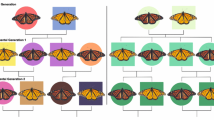Abstract
The effects of inbreeding on fitness and themaintenance of genetic load in metapopulationsof the endangered Glanville fritillarybutterfly (Melitaea cinxia) were examinedin four laboratory experiments. In FinlandM. cinxia occurs as a large metapopulationconsisting of small local populations with fastturnover, whereas in southern France thespecies has a more continuous populationstructure. In the experiments, we compared theperformance of crosses between full sibs,crosses between members of different familieswithin populations, and crosses betweenindividuals from different populations. Theseexperiments were replicated using insects fromtwo different regions, Finland and southernFrance, between which the frequency of naturalinbreeding should differ substantially becauseof differing population structure. In Finnishbutterflies, the rate of successful mating waslower among insects derived from small thanfrom large natural populations, probablyreflecting the effect of past inbreedinghistory. Mating between full sibs lowered egghatching rate in all experiments. Thisreduction of egg hatching rate was more severeamong French butterflies with a more continuouspopulation structure than among Finnishbutterflies with small naturally fragmentedpopulations and with a history of repeatedrounds of inbreeding in the past. This resultsuggests that recurrent inbreeding has led topartial purging of deleterious recessives fromthe Finnish metapopulation. Nonetheless,substantial genetic load still remains in thismetapopulation, and we discuss possible reasonswhy this should be the case.
Similar content being viewed by others
References
Bataillon T,Kirkpatrick M (2000) Inbreeding depression due to mildly deleterious mutations in finite populations: size does matter. Genet. Res., 75, 75-81.
Byers DL,Waller DM (1999) Do plant populations purge their genetic load? Effects of population size and mating history on inbreeding depression. Annu. Rev. Ecol. Syst., 30, 479-513.
Charlesworth D,Charlesworth B (1987) Inbreeding depression and its evolutionary consequences. Annu. Rev. Ecol. Syst., 18, 237-268.
Crnokrak P,Roff DA (1999) Inbreeding depression in the wild. Heredity, 83, 260-270.
Falconer DS,Mackay TFC (1996) Introduction to Quantitative Genetics, 4th edn. Longman, Harlow, England.
Frankel OH, Soulé ME (1981) Conservation and Evolution. Cambridge University Press, New York.
Hanski I (1999) Metapopulation Ecology. Oxford University Press, Oxford.
Hanski I (2001) Spatially realistic models of metapopulation dynamics and their implication for ecological, genetic and evolutionary processes. In: Plants stand still but their genes don't (ed. Silvertown J), in press. Oxford University Press, Oxford.
Hanski I,Kuussaari M,Nieminen M (1994) Metapopulation structure and migration in the butterfly Melitaea cinxia. Ecology, 75, 747-762.
Hanski I,Pakkala T,Kuussaari M,Lei G (1995a) Metapopulation persistence of an endangered butterfly in a fragmented landscape. Oikos, 72, 21-28.
Hanski I,Pöyry J,Pakkala T,Kuussaari M (1995b) Multiple equilibria in metapopulation dynamics. Nature, 377, 618-621.
Hedrick PW (1994) Purging inbreeding depression and the probability of extinction: full-sib mating. Heredity, 73, 363-372.
Hedrick PW,Kalinowski ST (2000) Inbreeding depression in conservation biology. Annu. Rev. Ecol. Syst., 31, 139-162.
Jiménez JA,Hughes KA,Alaks G,Graham L,Lacy RC (1994) An experimental study of inbreeding depression in a natural habitat. Science, 266, 271-273.
Kirkpatrick M,Jarne P (2000) The effects of a bottleneck on inbreeding depression and the genetic load. Am. Nat., 155, 154-167.
Kuussaari M (1998) Biology of the Glanville fritillary butterfly (Melitaea cinxia). PhD thesis, University of Helsinki.
Kuussaari M,Saccheri I,Camara M,Hanski I (1998) Allee effect and population dynamics in the Glanville fritillary butterfly. Oikos, 82, 384-392.
Lacy RC,Ballou JD (1998) Effectiveness of selection in reducing the genetic load in populations of Peromyscus polionotus during generations of inbreeding. Evolution, 52, 900-909.
Marttila O,Haahtela T,Aarnio H,Ojalainen P (1990) Suomen päiväperhoset. Kirjayhtymä Oy, Helsinki.
Nieminen M,Singer MC,Fortelius W,Schöps K,Hanski I (2001) Experimental confirmation that inbreeding depression increases extinction risk in butterfly populations. Am. Nat., in press.
Partridge L,Mackay TFC,Aitken S (1985) Male mating success and fertility in Drosophila melanogaster. Genet. Res., 46, 279-285.
Ralls K,Ballou J (1983) Extinction: lessons from zoos. In: Genetics and conservation: A reference for managing wild animal and plant populations (eds. Schonewald-Cox CM,Chambers SM,MacBryde B,Thomas WL), pp. 164-184. The Benjamin/Cummings Publishing Company, Menlo Park, California.
Richards CM (2000) Inbreeding depression and genetic rescue in a plant metapopulation. Am. Nat., 155, 383-394.
Saccheri I,Kuussaari M,Kankare M,Vikman P,Fortelius W,Hanski I (1998) Inbreeding and extinction in a butterfly metapopulation. Nature, 392, 491-494.
Saccheri IJ,Brakefield PM,Nichols RA (1996) Severe inbreeding depression and rapid fitness rebound in the butterfly Bicyclus anynana (Satyridae). Evolution, 50, 2000-2013.
Sharp PM (1984) The effect of inbreeding on competitive malemating ability in Drosophila melanogaster. Genetics, 106, 601-612.
Stevens JP,Bougourd SM (1988) Inbreeding depression and the outcrossing rate in natural populations of Allium schoenoprasum L. (wild chives). Heredity, 60, 257-261.
Wang J (2000) Effects of population structures and selection strategies on the purging of inbreeding depression due to deleterious mutations. Genet. Res., 76, 75-86.
Author information
Authors and Affiliations
Corresponding author
Rights and permissions
About this article
Cite this article
Haikola, S., Fortelius, W., O'Hara, R.B. et al. Inbreeding depression and the maintenance of genetic load in Melitaea cinxia metapopulations. Conservation Genetics 2, 325–335 (2001). https://doi.org/10.1023/A:1012538329691
Issue Date:
DOI: https://doi.org/10.1023/A:1012538329691




